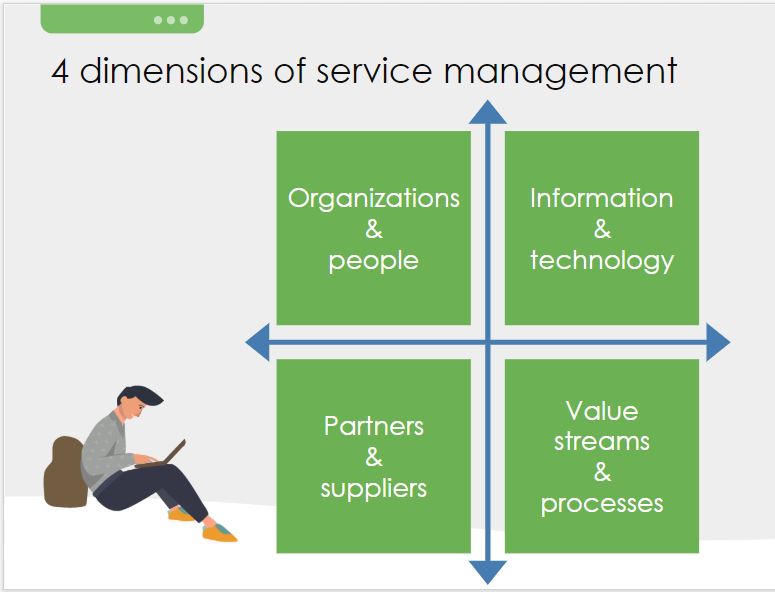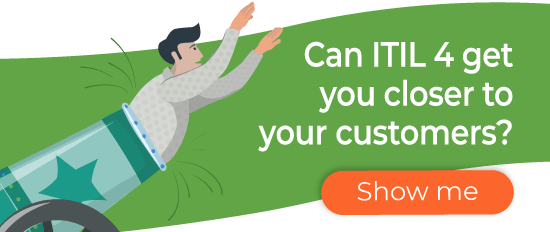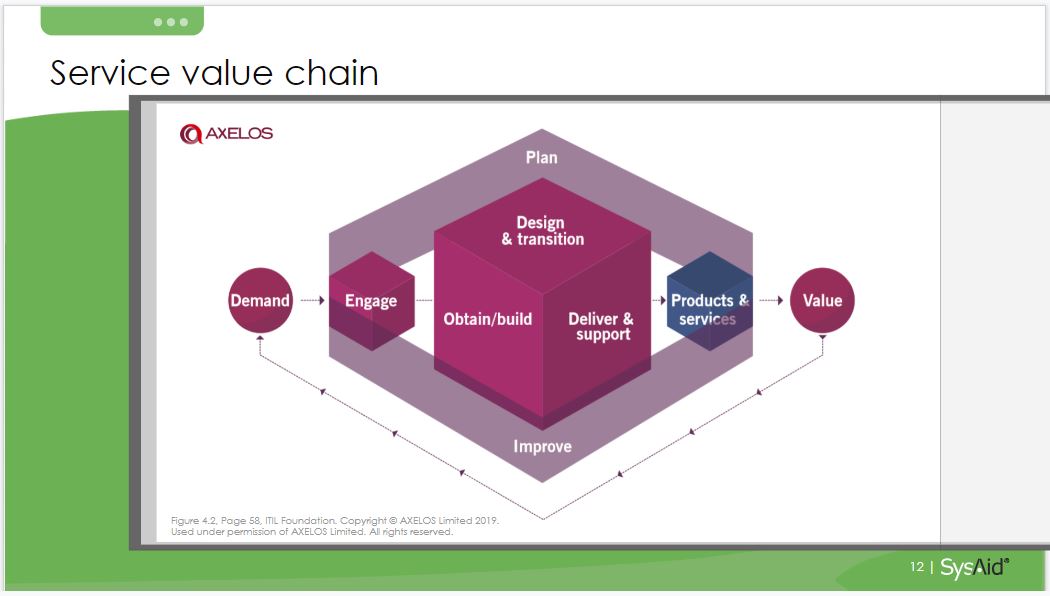Your ITIL 4 Questions – Answered!

I delivered a webinar about ITIL 4 on 6th March. The webinar was titled How ITIL 4 can help you get closer to your customers, and it included lots of stories to help participants understand how to use the ideas in ITIL 4 to help them co-create value with their customers.
I guess my stories went on a bit too long as I suddenly realized it was time to end and I hadn’t had time to answer all the great questions posted in the Q&A area of the webinar during the live session. Well, I know several participants commented that they loved my personal examples (thank you!), but I don’t want anyone to miss out on getting the information they need and requested, so here are some written answers to the questions you raised.
“Why practices not processes?”
Previous versions of ITIL described things like incident management and supplier management as processes. ITIL 4 takes a more holistic view. Everything is considered in the context of the four dimensions of service management:
- Organizations and people
- Information and technology
- Partners and suppliers
- Value streams and processes

Processes are obviously very important, but they are just a part of what is described for each practice.
ITIL 4 describes 34 practices. Each of these practices represents an organizational capability, something that organizations can do really well when – and only when – they have in place the right balance of the four dimensions of service management, and apply them as needed to help co-create value.
“Some more specific, more complicated than printer examples analysis will be great.”
I gave a very simple example of a value stream in one of the stories that I told during the webinar because it would have been difficult to describe a full, complex, value stream in the time available. However, for more complicated examples you need look no further than Appendix A of the ITIL Foundation publication. This provides four examples of more complicated value streams. Each one shows how multiple practices are involved in helping to transform demand from a service consumer into value.

“Many of us are already v3 certified and there is a lack of info regarding an upgrade path (there was one for V2 to V3)”
There will be a training course for people who already have 17 or more credits in the existing ITIL certification scheme. This will allow them to achieve ITIL Managing Professional with a single training course and exam. This course is not yet available, so you will have to watch out for announcements from AXELOS.
“Demand Management is missing among practices, any reason please?”
Superficially it may seem to be missing, but that’s because management of demand is actually a much bigger deal in ITIL 4 than it was in ITIL V3. It underpins everything. Every value stream starts with demand and ends with value. Understanding and managing this demand is part of the Engage value chain activity, with many different practices contributing to this. Here’s the slide I showed that explains this:

“The AI / Automation question seems to be very dependent on the area of the business and its focus (external/internal, etc.) and whether it’s customer-facing or not. Do you have any specific examples or opinion on this?”
Gosh, that is a huge topic to cover in a brief written answer to a blog.
ITIL 4 recommends that organizations should “Optimize and automate,” but it doesn’t provide specific examples of how automation should be implemented.
Most organizations that I work with use IT services to help their customers automate business processes – that is kind of the point of running IT. As you say, the specifics of how this is done depends on the industry, and the needs of the service consumers, so every IT service is an example of automation! Most organizations also use automation to help them manage IT services, for example by using a tool like SysAid to log and manage incidents, problems, and changes.
“Is SysAid ready to support Automation and AI?”
I asked Doron Youngerwood from SysAid to answer this question. Here is what he had to say:
At SysAid, we’ve put automation at the heart of IT service management. This includes automating ticket routing to ensure timely resolution in line with every organization’s SLAs. Alerts and time indexes drive your mean time to resolution (MTTR) down, and your agents’ productivity up. Since the ticket is automated and sends itself where it needs to go, tickets are no longer triaged to the wrong team and requests are never sent to the wrong person for authorization. SysAid automates the hard work, so your IT agents remain the heroes in your customers’ eyes.
Later in 2019, we’ll be launching new automation and AI capabilities to further evolve service management – better, faster, and cheaper than ever before. This includes our new chatbot and service orchestration tool.
“As we are going through major digital transformation like containerization and micro services, it is getting difficult to control the changes happening in the infrastructure, how could ITIL 4 help in such a situation please?”
One of the driving forces behind the service value system, and value chain, described in ITIL 4, is the need to support digital transformation. Each organization can design value streams that support the way that they work, including fast iterative value creation where this is appropriate. The next set of ITIL publications and training will include “High Velocity IT,” which is entirely focused on how to use ITIL 4 in these environments.
“Can organizations have flexibility to start with ITIL 4 and choose with any practice?” / “How can I start making improvements based on ITIL 4?”
I have combined these two questions, as they are both about how you can adopt ITIL 4 in your own organization.
Previous versions of ITIL stressed the need to “adopt and adapt” ITIL but offered little guidance on how to do so. ITIL 4 includes guiding principles, which are intended to help you with this. The guiding principles are:
- Focus on value
- Start where you are
- Progress iteratively with feedback
- Collaborate and promote visibility
- Think and work holistically
- Keep it simple and practical
- Optimize and automate
This is probably the most practical part of ITIL 4, as it explains how you can use the guidance in your specific context. You certainly can start with any practice, and you shouldn’t try to do too much at once. If you think about these guiding principles then it’s likely you’ll be able to identify some simple and practical steps you can take to improve how you are currently working, then use feedback to see what value these changes created, and progress iteratively to make more improvements. Don’t automate things too quickly, think about how you are working and optimize first. Collaborate with all the impacted stakeholders, and think about end-to-end value streams, not individual practices.
“Is it possible to get the recording of this video sent to our emails?”
You can follow this link to get access to the recording. Do listen as often as you want, download the slides and other helpful collateral, and feel free to share this with any of your colleagues who might benefit from the webinar.
“What is the name of the relatively slim book again? Sorry, I lost my audio after that.”
The first ITIL 4 book that was published in February 2019 was ITIL Foundation: ITIL 4 Edition. It’s only about 200 pages long, compared to the five volumes of ITIL V3 that had more than 1,700 pages between them. This relatively slim volume describes the whole of ITIL in enough detail for you to get a good grasp of the components and how they work together. Future publications will provide more detail on specific areas.
If you had sound problems during the live event, then you can listen to the webinar again by following the link above.
Conclusion
You won’t learn everything you need to know about ITIL 4 in one webinar, or one blog post, but I hope that I have helped you to get started on the journey.
If you want to learn more about how ITIL 4 can help you create more value, then you can
- Read the ITIL 4 Foundation publication
- Take an ITIL 4 Foundation training course
- Read more blogs about ITIL 4 (I will be writing some of these and posting them here on the SysAid Blog over the next few weeks)
If you have ideas on what additional ITIL 4 content SysAid could offer to help you, please post your ideas in the comments below, or on Twitter at @sysaid.

Did you find this interesting?Share it with others:
Did you find this interesting? Share it with others:









